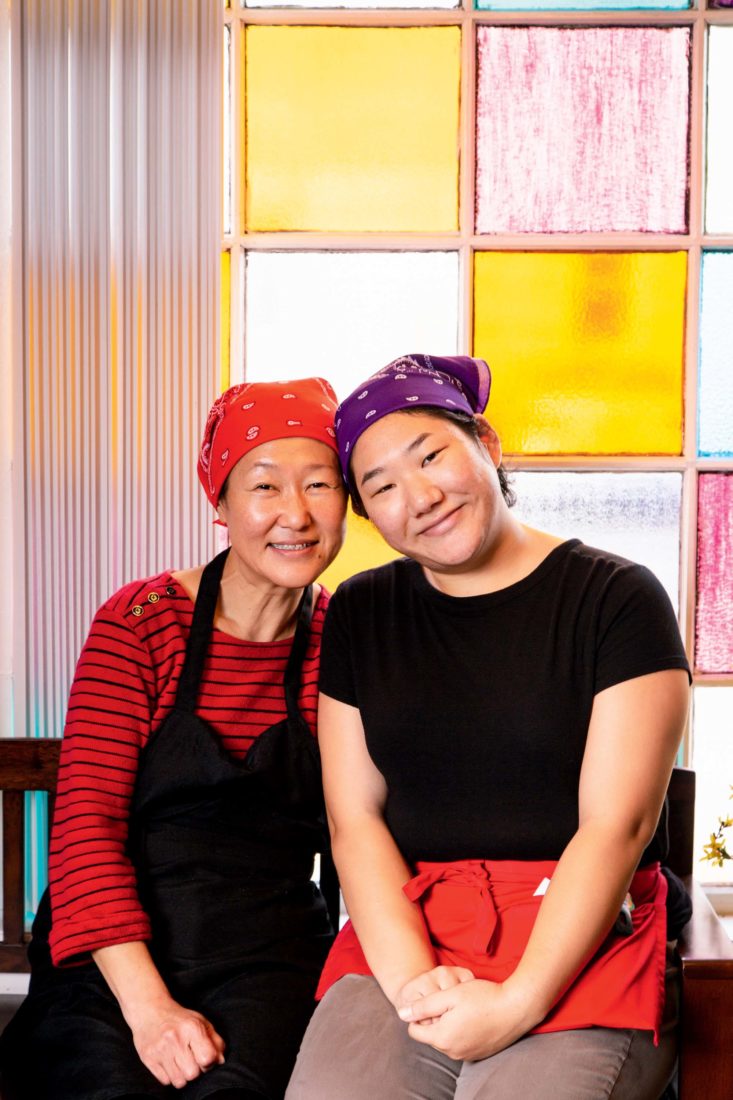As I drive into downtown Macon, Georgia, the familiar arrow-shaped Len Berg’s sign heaves into view, pointing down the alley to the old brick shoebox of a restaurant. Founded in 1908, closed in 2005, Len Berg’s was famous across the state for fried chicken in a lacy crust, creamy fried corn, buttered early peas, and house-churned peach ice cream. My father, who worked on the other side of the alley, treated me to lunch there when I was a boy. On the way out, we took turns mashing the buzzer by the door with the sign that read, PRESS BUTTON TO PRAISE COOK.
Each time I return to Macon, I drive this way. For the longest time, the old Len Berg’s stood empty. More than once, false hope bloomed. In 2012 a couple with the last name Lee opened Lee Berg’s in the same spot. They didn’t last long, in part because they pulled out the old counter and put in a buffet. Fried chicken dies a soggy death on a steam table.
This time, belief pays off. Below the big white arrow, still embossed with the old Len Berg’s logo, a smaller sign reads, GRAND OPENING. Atop the building, a larger arrow points downward, heralding KIMCHI FACTORY.
Things didn’t begin well for the restaurant. On opening day last summer, Miyang Kim fed a probation officer who walked across the street from his office and a repairman who came to fix the walk-in and went home with an order of bibimbap. Just two customers, and only one paid. But word of Kimchi Factory spread quickly. By week two, Kim and her daughters Grace and Sunny, who wait tables and run the register, struggled to keep up with the customers who arrived to see what had become of Len Berg’s, stayed to eat the restaurant’s namesake dish, and pushed the modern version of that buzzer, lighting up social media. “Teenagers who dated here come back with the families they made,” Miyang Kim tells me when I introduce myself. Head wrapped in a bright red bandanna, she leans in to say, “People show me pictures. This is a big responsibility, to open a new restaurant here.”

The Kims have retained some of the Len Berg’s touchstones. The vintage color-block front windows that looked discordant on a meat-and-three now appear like modern flourishes installed by a hip architect. Once dim and jammed with portraits of Confederate generals, the warren of small dining rooms now glows a luminous red. Tiny clay sculptures, shaped by Kim’s youngest daughters, Meju and Yeju, stare back.
True to her restaurant name, Kim is very good at kimchi, the spicy fermented vegetable mixture often made with cabbage. Dumplings stuffed with kimchi and glass noodles come in a lustrous dough that turns translucent in the steamer. Dipped in a mix of soy sauce and vinegar, they taste light and bright. Kimchijeon, pancakes stirred with kimchi and green onion, arrive crunchy at the rim and creamy at the core. Dunked in that soy and vinegar mix and enjoyed with a brown-bagged bottle of white wine, those pancakes might be the best thing on a menu packed with good stuff.
Kim’s skill with kimchi dishes was born in Gwangju, her hometown at the foot of the Sobaek Mountains in the southwestern corner of South Korea. Long a base for the best kimchi makers in the country, the city now hosts the World Institute of Kimchi, where researchers study fermentation and kimchi’s possible benefits for everything from brain function to hair loss.
At Kimchi Factory, the roster of main dishes goes deep. After two lunches and a dinner, here’s what I know: Instead of galbi, pork ribs served here on a sizzling platter like fajitas, try one of the soups or stews, like sundubu-jjigae, made with soft tofu and pork. Or knife-cut noodles, served in a subtle stock that bobs with black mussels and pink shrimp.
I default twice to bibimbap. A jumble of rice and squid and vegetables, seasoned with sesame oil, my favorite version here arrives in a heated stone bowl, capped with a fried egg. Pierce the yolk, squirt chile paste from an oversize bottle, and a rich sauce coalesces, ideal for soaking up that rice.
After Kim immigrated in 1994, she cooked the foods of her birthplace to center herself, first in Mississippi, then in Georgia. As she fell asleep each night, she tasted through her mother’s recipes, searching memories for ingredients and techniques. Cooking at the fellowship hall of a Korean Presbyterian church in suburban Atlanta, she befriended women from other parts of her home country. In a room full of good cooks, her kimchi stood out. Just as it did when she later worked in the cafeteria of the Kia plant in West Point, Georgia.

In America, Kim has faced down big challenges, including two divorces and a car wreck that nearly killed her and required a hip replacement. Driving the first time to Macon, to take a job cooking and cleaning for Korean workers at the Kumho Tire facility, she saw new possibilities in this once-beleaguered city, now in the midst of a downtown renaissance.
Kim brings big dreams to her small restaurant. She wants to grow it into a franchise and build a mission to give back to this city that has given so much to her. “This place is a big tree,” she says of Macon. “And now I live here under that tree, safe and happy.” As I reach to pour cups of chrysanthemum tea, she reaches for another metaphor that speaks to the possibilities of this city in this moment. “Macon looked messy when I got here,” she tells me, her big smile pressing against her small mask. “Now it’s breathing again.”








